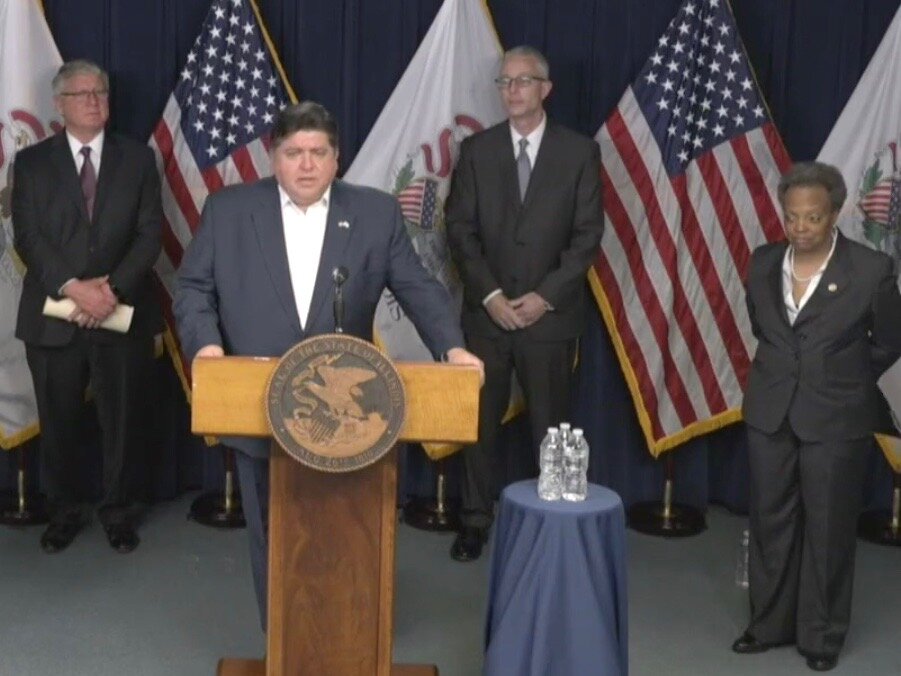April seclusion may halt profusion of COVID-19 cases
Pritzker extends stay-at-home order as Illinois coronavirus deaths near 100
Gov. Pritzker gives his daily coronavirus briefing Tuesday, joined by Chicago Mayor Lori Lightfoot at right. (Illinois Information Service)
By Ted Cox
Gov. Pritzker extended the statewide stay-at-home order through April on Tuesday in hopes of halting the spread of the coronavirus as Illinois closed in on 100 deaths from the disease.
The governor made the announcement as Public Health Director Dr. Ngozi Ezike reported 937 new COVID-19 cases Tuesday and 26 new deaths, bringing the state to the brink of 6,000 infections and 100 deaths. Illinois now has confirmed 5,994 cases of the coronavirus, resulting in 99 deaths, and the disease has been reported in 54 counties.
Pritzker said he was intent on “saving as many people’s lives as possible. That’s the one goal that I will put above all others every single time.”
The governor said he’d formally issue an executive order Wednesday extending the restrictions on gatherings of more than 10 people, closing nonessential businesses, and calling on Illinoisans to stay home as much as possible. That would also extend the statewide disaster proclamation and the shuttering of schools, although he praised educators for swiftly shifting to online eduction.
School cancellations classified as “Act of God Days” will instead become “Remote Learning Days,” he said, with no need to make up days lost. Local school officials have been granted broad leeway to accommodate online learning to the capability and resources available to their students.
Pritzker emphasized that the state maintains a moratorium on evictions and utility shutoffs as residents across the state struggle to pay bills in the midst of the economic shutdown.
“We need to maintain our course and keep working to flatten the curve” of rising infections, Pritzker said, adding that more than a third of beds in Intensive Care Units at Illinois hospitals are currently occupied by coronavirus patients, and a quarter of ventilators statewide are already hooked up to COVID-19 sufferers.
“The most severely ill will require hospitalization, and we want to be able to provide that,” Ezike said, explaining the need to keep hospitals from being overrun with COVID-19 patients.
“Our greatest risk of hitting capacity isn’t right now, but weeks from now,” Pritzker said, and efforts to slow the spread of the disease won’t work “if they’re piecemeal across the state.”
Ezike emphasized that additional precautions are necessary because of new guidelines from the Centers for Disease Control and Prevention warning that people can be infectious for the coronavirus a day or two before showing symptoms. “All the illness is not reflected in the numbers because of the limits of testing,” she said.
“What we really want is for people not to get this in the first place,” Pritzker said.
Pritzker said the pandemic has spread across all 50 states, “and that’s the price that we will continue to pay for the lack of early robust national testing.”
“This virus is lethal and growing,” said Chicago Mayor Lori Lightfoot, who joined Pritzker’s daily coronavirus briefing at the Thompson Center in full support of the governor’s actions. “This may not be what residents want, but it’s what we need.” She added, “The number of cases will continue to rise and get worse before it gets better.”
“We still don’t know exactly when this immediate crisis will pass,” Pritzker said. “We have to see the peak here,” in the number of infections. “We haven’t seen the peak.”
The number of cases will have to decline before the state can consider lifting the stay-at-home order. “That time is not today,” Pritzker said, “and it’s not April 7,” the original end of the order imposed a week and a half ago.
“Stay home, save lives — period,” Lightfoot said.
Pritzker said the state was continuing to try to release “as many low-risk offenders as possible” from prison, without jeopardizing public safety. That came after the first COVID-19 death at the Stateville Correctional Center, with 32 other inmates testing positive for the disease, as well as 18 Department of Corrections employees across the state. But Pritzker stressed that prisoners would be treated for the disease just as anyone else would be, including access to intensive care and a ventilator. “An incarcerated person is a person,” he said, “and my administration will not be in the business of claiming one life is worth more than another.”
Pritzker said that, with two teenagers of his own at home, he felt for the students missing their classmates and teachers as well as their landmark school events. “I won’t try to tell you that a Zoom prom is the same as a real prom,” he said, making reference to the suddenly popular teleconference web service. “It’s OK to be sad.”
But he also urged Illinoisans to stay cheery, and if possible to volunteer or seek other work in fighting the pandemic.
“Now is the time to step up,” Lightfoot said, echoing Pritzker in calling for those especially with medical training to join the effort.
Pritzker said medical students close to graduation or completing courses would potentially be granted temporary licenses to practice or otherwise aid in the effort, adding, “We need anybody and everybody who has medical training.”

